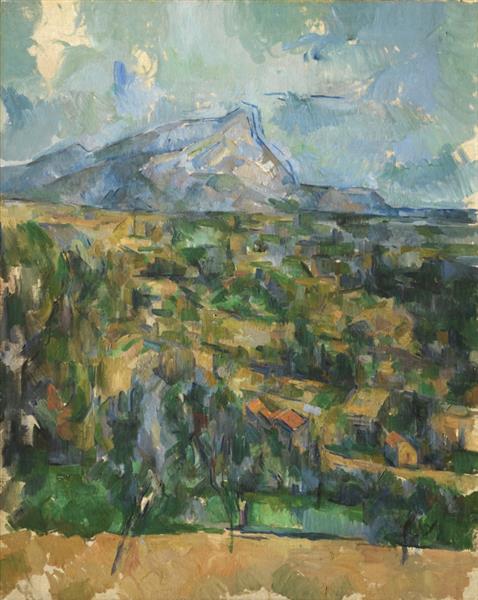Description
Paul Cézanne's Mont Sainte Victoire, painted between 1904 and 1906, stands as a monument within the evolution of Post-Impressionism and the transition towards modern art. This landscape captures the iconic mountain that has been a source of inspiration for Cézanne throughout his career, representing not only a physical place in Provence, but also a symbol of his artistic quest and understanding of nature. The panorama conveys an almost tactile perception of geography, where the mountain is not only visualized, but felt through the application of a lively, gestural brushstroke.
Cézanne uses a palette characterized by the intersection of blue and green hues that evoke a natural Mediterranean environment. Colors play an essential role in building the atmosphere, with the mountain dominating the composition in shades of gray, blue and ochre, contrasting with the vibrant greens of the foreground. His focus on nuance and the shape of light and shadow contributes to an almost sculptural quality in his depiction of the landscape. Whereas in the artist's earlier works the forms are more eloquent and detailed, here Cézanne seeks to simplify, to reduce to the essential, allowing the viewer to not only see the mountain, but to feel the solidity of its presence.
The composition of the work is carefully balanced. Mont Sainte Victoire occupies the background, firmly outlined yet softened by the artist’s brushwork. The foreground is populated by dense vegetation and what appear to be agricultural land, which act as a counterweight to the firmness of the mountain, drawing the eye to the landscape at hand. This relationship between foreground and background is a brilliant example of Cézanne’s interest in how elements of the landscape interact with one another, creating a sense of depth and perspective that anticipates Cubism.
It is interesting to note that throughout his career, Cézanne painted Mont Sainte Victoire on numerous occasions, establishing a constant dialogue with the shape and light of the mountain, as if each work were a different chapter in his exploration of reality. This approach insists on the idea that perception is a dynamic activity, in which each look at an object is unique. This philosophy is reflected in the surface of the painting, which is imbued with a palpable texture, as if the viewer could touch the layers of colour and brush strokes.
There are no human figures present in this canvas, which is remarkable. Rather than distracting attention from the landscape with narrative elements, Cézanne chooses to present a pure, almost spiritual vision of nature. The absence of characters allows the mountain to become the sole focus of attention, a silent witness to the passage of time and the changes occurring in its environment. This act reinforces the idea that nature has its own narrative; in its majesty, in its stillness, in its eternity.
In conclusion, Mont Sainte Victoire is not only a manifestation of Cézanne's technical mastery, but a profound reflection on the experience of observing nature. Through his innovative palette, compositional approach and notable absence of the human figure, Cézanne invites us to reconsider the act of seeing and to appreciate the complexity of the landscape around us. This work thus becomes a testament to Cézanne's quest to find truth in form and color, opening up paths that would influence later generations of artists.
KUADROS ©, a famous painting on your wall.
Hand-made oil painting reproductions, with the quality of professional artists and the distinctive seal of KUADROS ©.
Painting reproduction service with satisfaction guarantee. If you are not completely satisfied with the replica of your painting, we will refund 100% of your money.

